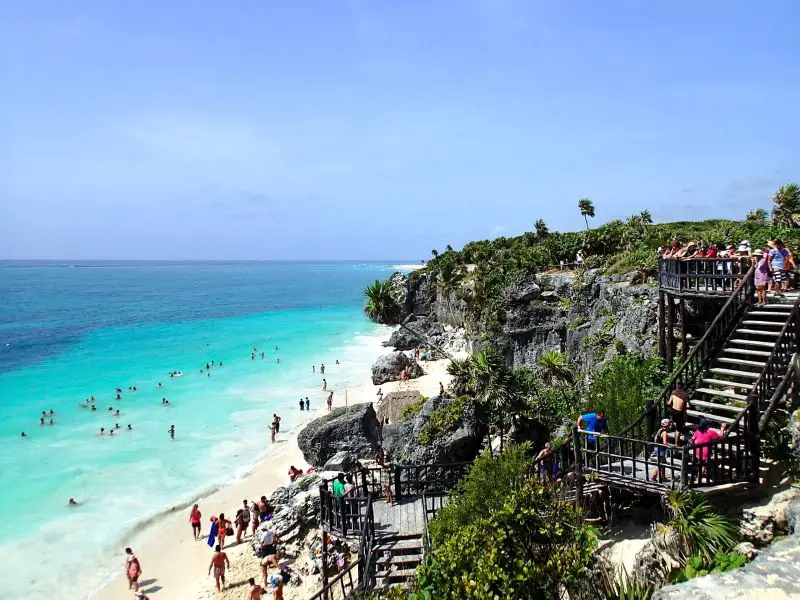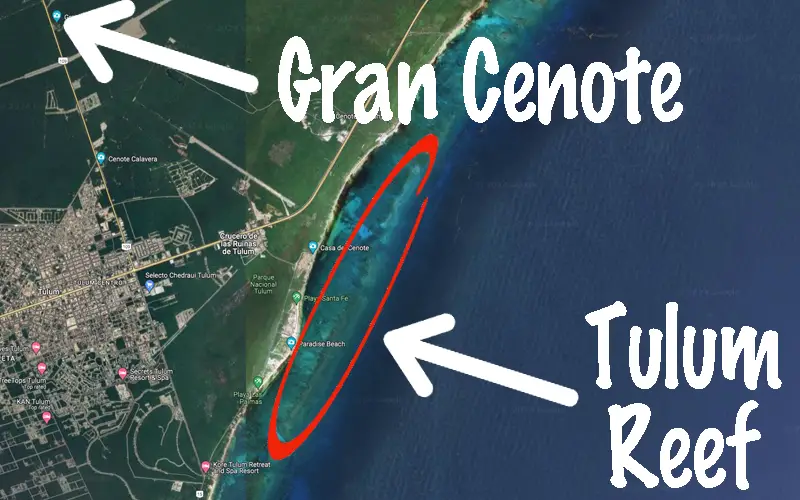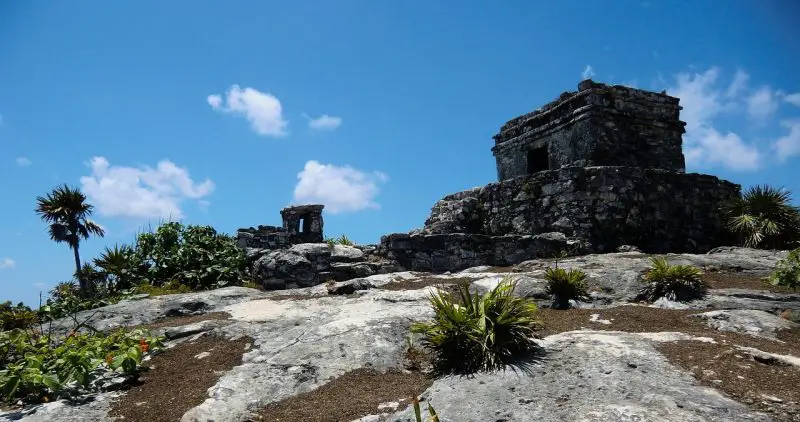
Along the picturesque coastline of the Yucatán Peninsula in Mexico, about 80 miles (130km) south of Cancun, Tulum offers surprisingly great snorkeling . While its ancient Mayan ruins draw visitors from around the world, Tulum’s crystal clear waters and vibrant coral reefs offer an equally captivating experience beneath the ocean surface. Tulum is home to the Mesoamerican Barrier Reef, the second-largest coral reef system in the world (after the Great Barrier Reef). It stretches over 600 miles (almost 1000km) along the coast of Mexico, Belize, Guatemala and Honduras.
Tulum’s snorkeling sites are known for their accessibility and diversity. Both beginner snorkelers and seasoned enthusiasts should be able to enjoy the marine life. In our opinion, the most popular destination is the Tulum Reef, located just a short distance offshore. Loads of colorful fish and coral formations make this one little paradise within the Caribbean Sea.
Many snorkelers combine their trip with a visit to the Gran Cenote. Cenotes are natural sinkholes formed by the collapse of limestone bedrock. This reveals subterranean rivers beneath the earth’s surface with often allow for swimming and snorkeling within crystalline waters. Even though the marine life isn’t as interesting as along the Tulum Reef, we share more details about this Cenote further down below.
How to get there
Most tourists fly to Cancun Airport, from where they take a bus or taxi. Expect this trip to take somewhere between 1,5 and 2 hours.
If you’re staying in Tulum town or nearby areas, you can easily reach the coastline by car, taxi, or bicycle (many people rent a bicycle). Tulum is well-connected by roads. There are several rental car agencies, taxis, and bike rental shops available. Many hotels and resorts also offer shuttle services to the beach.

1. Snorkeling the Tulum Reef
Location
Maybe the best thing to know is the fact that the Tulum Reef is located close to the shore (see our map above). Yes, you need to join a boat tour but there are plenty of snorkel services along the shore. Many tour operators in Tulum offer snorkeling excursions that include transportation to and from the reef. They often come with (rental) snorkel gear and an instructor. Tours typically depart from Tulum’s beach area and may visit multiple snorkeling sites along the reef. Most people go for a 1 or 2 hour trip (which is more than enough if you ask us).
Ocean Floor and Coral Reefs
Just to be clear, you’ll snorkel directly off the boat. The ocean floor at the Tulum Reef is characterized by vibrant coral reefs. As you snorkel along the reef, you’ll encounter the following coral formations: Brain, elkhorn and staghorn. In between these coral formation you’ll find sandy patches, rocks and seagrass. The coral reefs provide a home to various fish species, which makes it an essential part of the reef ecosystem.
Water Conditions
The waters around the Tulum Reef are typically warm, clear, and calm. Quite obviously, this provides excellent (at least good) visibility for snorkelers. As long as weather conditions are calm and sunny, the clarity of the water allows you to easily see the coral and marine life. The water temperature remains relatively consistent year-round, making snorkeling possible at any time of the year. We explain the climate further down below.
Marine Life
Tropical Fish
Typical fish species for the Tulum Reef include angelfish, parrotfish, sergeant major, butterflyfish, and triggerfish. If you’re lucky you might be able to observe a barracuda, an octopus or even lobster.
Sea Turtles
Tulum is known for its local population of green sea turtles and loggerhead turtles. Besides eating algae, they often chill at the ocean floor or simply float around. Keep in mind that they can also nest on the beach.
Rays
It’s quite common to spot a stingray or spotted eagle ray. Spotted eagle rays usually float above the seabed and can easily be identified by multiple white spots on their bodies.
Coral Reef Invertebrates
Besides all the fish, expect a variety of coral reef invertebrates: Sea fans, sea anemones, sea cucumbers, shrimp and crabs.
“Snorkel In Tulum”-Tour
One of various companies to choose from is ‘surprisingly’ called “Snorkel in Tulum” (snorkelintulum.com). They offer snorkel excursions, Mayan ruins sightseeing, fishing adventures and more. Here’s their location:
2. Snorkeling the Gran Cenote
The “Gran Cenote” is a natural cenote located near Tulum on the Yucatán Peninsula in Mexico. Cenotes are appealing geological formations found predominantly in the Yucatán Peninsula and parts of Central America. They are characterized by natural sinkholes or underwater caves filled with groundwater. These cenotes are formed by the gradual dissolution of limestone bedrock over millions of years. This finally results in the collapse of the surface which exposes the underlying groundwater.
The formation of the Gran Cenote began thousands of years ago. Over time, rainwater and groundwater gradually seeped through the porous limestone bedrock. This process dissolved minerals and lead to extensive underground cave systems. As the roof of these caves weakened, sections of the limestone collapsed. Sinkholes or cenotes are the result.
The Gran Cenote, like many other cenotes in the region, formed through this process of geological erosion and collapse. The cenote is connected to a network of underground rivers and caverns, which serve as a refuge for a variety of fish species and even sea turtles.
Today, the Gran Cenote is a popular tourist destination. Snorkelers from around the world come to its crystal clear waters, stunning rock formations and diverse ecosystem. Whether snorkeling or diving, the Gran Cenote offers a unique and unforgettable experience. We find this video very helpful to give you a good impression of what to expect:
Oh yes…just one thing: If snorkeling is your primary goal, don’t expect a very diverse marine life. You’ll spot some fish and a good amount of sea turtles, but that’s about it. In our opinion, visiting the Gran Cenote is all about enjoying a little adventure where both nature and history come together. Furthermore, if spotting sea turtles is enough action for you, this snorkel spot will do the trick.
Sustainable Tourism
In addition to its abundant marine life, Tulum supports sustainable tourism and marine conservation. Local eco-tour operators and marine parks prioritize the protection of fragile coral reefs and marine habitats. They do so by implementing responsible snorkeling practices and educational initiatives to raise awareness about the importance of preserving these precious ecosystems for future generations. One thing to at least use is reef-friendly sunscreen. We cover reef-friendly sunscreen in our article about UV protection for snorkelers and swimmers.
Beachfront Dining Options
Beach Clubs
Many beach clubs in Tulum offer not only lounging areas with sunbeds and umbrellas but also on-site restaurants and bars. These beach clubs often serve a range of dishes, from fresh seafood to international cuisine. There’s really a relaxed atmosphere and you can even enjoy your meal with your toes in the sand.
Upscale Restaurants
Tulum’s beachfront includes a few upscale restaurants that offer gourmet dining experiences with the Caribbean Sea in the background. These restaurants specialize in seafood and Mexican cuisine.
Casual Eateries and Cafes
If you’re looking for a more casual dining experience, you’ll find plenty of options along Tulum’s beachfront. From laid-back cafes serving breakfast and brunch to casual eateries offering tacos.
Pop-Up Bars and Food Stalls
Additionally, Tulum’s beachfront is known for its vibrant pop-up bars and food stalls. This is where you grab a quick bite or refreshing drink (like local street food, cocktails and other snacks).
Maya in Tulum

The Maya civilization flourished in Mesoamerica for thousands of years, reaching its peak between 250 and 900 AD. During this time, the Maya developed sophisticated city-states characterized by monumental architecture, advanced agricultural practices, and a rich artistic and cultural tradition. Tulum, known as Zama or “City of Dawn” in Maya, served as a prominent trading hub and coastal fortress for the Maya civilization.
At the heart of Tulum’s cultural heritage lies its iconic archaeological site. Dramatic cliffs overlook the Caribbean Sea. This site is a testament to the architectural skills of the Maya, with its well-preserved temples, palaces, and defensive walls dating back to the late Postclassic period (around 1200 AD). Visitors to the Tulum archaeological site can walk among its ruins and breathtaking panoramic views of the turquoise waters below. Highlights include the Temple of the Frescoes and the Temple of the Descending God.
When is the best time to go?
The best time to snorkel in Tulum is during the dry season, which typically lasts from November until April. During this period, you can expect generally calm seas, sunny weather and excellent underwater visibility.
Weather
Tulum experiences a tropical climate, with distinct wet and dry seasons. The dry season lasts from November until April. During this season you often get clear skies, minimal rainfall and comfortable temperatures. Daytime temperatures during this period range from 75-85 °F (around 24-29 °C).
Underwater Visibility
During the dry season, the waters off the coast of Tulum tend to be clearer and more transparent, offering excellent visibility for snorkelers. With fewer rainstorms and runoff from the land, sedimentation is reduced, resulting in clearer water conditions that allow you to see farther.
Crowds
Unfortunately, we must say that the dry season also attracts a lot of tourists. But that’s not as bad as it sounds. While you find more people on the beach, it also means more amenities and services available to travelers.
Hurricane Season
It’s important to note that Tulum could include hurricanes and tropical storms, particularly during the wet season from May to October. While major hurricanes are relatively rare, there is a higher risk of chilly weather and rough seas. Snorkeling might be prohibited.
Inspiration
For people who travel along the east coast of Mexico, a little towards the north from Tulum there’s great snorkeling in Cozumel. Even further towards the north you can also enjoy some marvelous snorkeling in Cancun. If you’re staying on the west coast of Mexico, check out our review about snorkeling in Nayarit.
